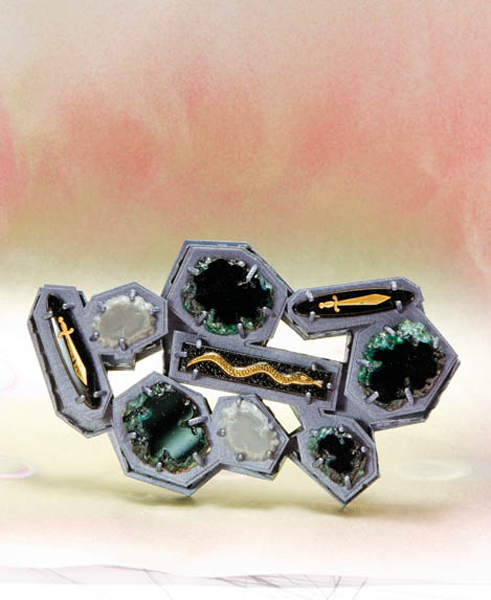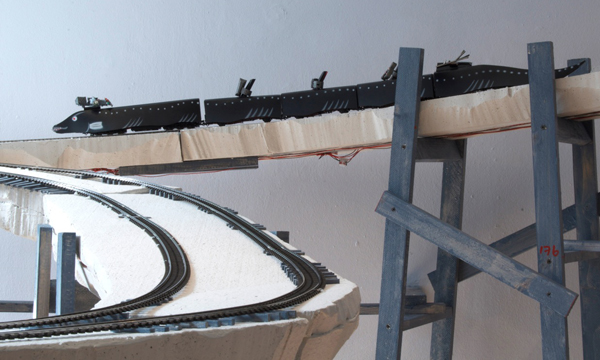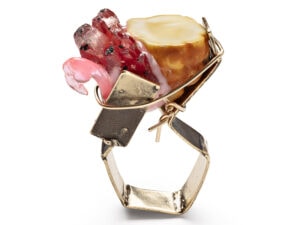
Susan Cummins: What does Unheimlich, the title of your exhibition, mean?
Helen Britton: Unheimlich can be loosely translated as “uncanny,” although the German meaning is more complex. When we look at the text “Perturbante” written for this exhibition, which specifically addresses the interpretation of this word, Maria Cristina Bergeson writes:
When Sigmund Freud’s seminal work (Das Unheimliche, 1919) was translated (into Italian), the term “the disturbing” was used, deriving from perturbamento, the state of people or things that have been deeply disturbed or upset.
The accent is, therefore, on the effect of a shock, of a loss, of tranquility and serenity. What is it that produces this reaction? What is the origin of such profound disturbance?
Let us attempt a synthetic definition: the arcane sensation of bewilderment and displacement experienced by a person who has to face up to “everything that should have remained secret, hidden, but which has instead come to the surface.” (Freud)
You have said that this show was based on some childhood memories. Can you tell that story?
Helen Britton: The story is told in the text I wrote to accompany the exhibition, which is as follows:
Unheimlich: The Ghost Train
When I was growing up in Australia, there was the yearly show. In fact, there still is. Everyone comes to town to show their best animal, their best vegetable, and the best thing they can bake, pickle, or preserve. There are show bags to be had, wonders to be seen—shearing, wood chopping, dogs with wild hairdos—a fabulous spectacle connecting the country to the city.
Then, there is the sideshow alley. Fun rides, shooting parlors, mangy and bad tempered ponies that children can ride at their own risk. It’s a seedy scene with rumors of sex and violence, of transient livelihoods—jailbirds and petty criminals, the underbelly. Nestled in amongst all this are The Ghost Trains.
As a small child, in a state of fear and excitement, I would avert my eyes when walking past a Ghost Train. A glimpse was enough. I was also of the firm belief that the disused railway sheds on the other side of the swamp where I grew up were haunted, and that even touching the walls of these buildings with a piece of wood would lead to certain death. The fear was genuine, but so was the fascination. Carefully kept trinkets from that distant past have become symbols of a primal contradiction—the allure of the unknown and the ultimately unknowable.

So, yes, the point of departure for this work came from an exploration of primal experiences of The Unheimlich, which are obviously deeply entrenched in every childhood in some form or another. I selected five jewelry objects from my collection of low-end costume and children’s jewelry, four of which I have owned since I was a small child and one of which is a later addition. These, then, became the graphic symbols of “Unheimlich.” The shark’s tooth, which I have had since I was 12 years old, sparked my first serial work Lucky Tooth, an addition of 50 silver and 10 18-karat-gold, press-formed shark teeth, which were hidden in the show bags. The idea of the show bag stems very much from my childhood, and every Australian of my generation would understand this work, but that is a chapter in its own right.

Helen Britton: What is important to understand from the outset is that Unheimlich is one work containing many components and not a jewelry exhibition, per se. With Unheimlich, I created a complete walk-in world where the viewer was surrounded by the work and entered into the work/world to discover the many elements that made up the work, including graphics, the construction, the steel trains carrying the fleeting glimpse of the jewels, the placed/hung/hidden jewels, the “show bags,” the sound. I wanted to create a complete experience and to give myself the space and the challenge of doing that, and also to create a world and a viewing experience that was alive and risky and delicately balanced on the edge of popular culture, which is ever a main theme in all my projects.
Being asked to make another major show for Schmuck the year after a major show in Nürnberg was a challenge, and it was important for me to make a “complete” work and something totally new, not only for myself, but also for my audience. The open space of Galerie Spektrum is, of course, ideal for such a work, and without the patience and support of Jürgen Eickhoff, of Märklin and of Roland Pollack, the project would not have been possible in this form.

Helen Britton: The narrative or theme in this work has been a preoccupation for a number of years, both in the fact that I ride in, photograph, and film Ghost Trains whenever I can and that darker works have always appeared in contrast to their flipside. Part of the reason for this exhibition was to give space and concentration to make work that explored the theme and to see what happened, what came out. Another part of this exhibition was, as in answer to the last question, to build a complete work that encompassed all facets of the things I produce. I don’t think you can capture feeling, but perhaps you can convey something more sinister, more mysterious than usual, and as this is the first body of work in this direction, we will see what happens next. As you know, I like to pursue themes over many years, so I dare say at some point there will be Ghost Train 2: The Return of the Unheimlich or something like that.
What kinds of questions do you ask yourself in the process of making things?
Helen Britton: What I am having for dinner? Is there wine in the fridge? I do a lot of thinking beforehand and just as much afterwards, but I do experience the act of creating a body of work as something profound and not necessarily articulable. It is only when I have no idea what will come out, no idea what I am doing in that uncomfortable zone where one relies on instinct and not ideas, that I know I am outside the boundaries of what I have done before, that is, in a very interesting place. It is a risky business but fascinating and ever generative, and for that reason, I leave the heavy baggage of thinking, ideas, and rationality at the door of my studio.
You have been honored with many shows and awards in your career, including a show at the Pinakothek der Moderne Nuremburg last year. What are your future ambitions as a jeweler, living in one of the epicenters of the contemporary jewelry field far away from your native Australia?
Helen Britton: Well, I am only based in Munich. I am writing this in Brooklyn, and next week I will be in Australia to plan future projects, meet my collaborators, open my exhibition at Gallery Funaki, and give a joint master class at RMIT with my collaborator Justine McKnight. Justine, Michelle Taylor, and myself are working on a new series. Yutaka Minegishi, David Bielander, and I have things afoot. Laura Deakin is helping me compile a complete archive of all works created since 1991, and I am really looking forward to spending time in Idar Oberstein at the invitation of Theo Smeets to pursue another longterm interest in the global circulation of stone. That covers this year, and the following two years are also fairly well full with a major exhibtion at Sienna Gallery in 2016 and a mid-career retrospective in Western. After that, I am planning on becoming a housewife.
What have you seen, heard, or read recently that you can recommend?
Helen Britton: The film about Nick Cave called 20,000 Days on Earth and The Thousand Autumns of Jacob de Zoet by David Mitchell.
Thank you.






